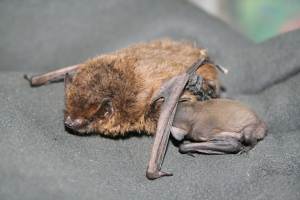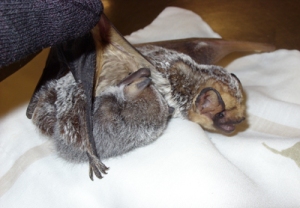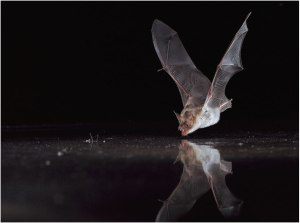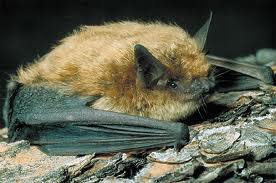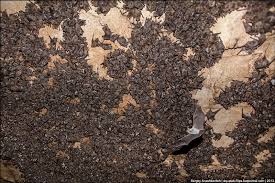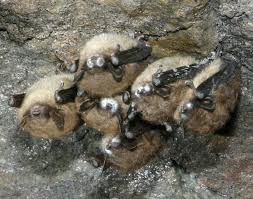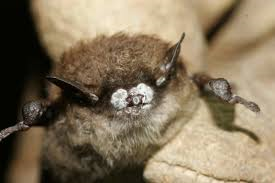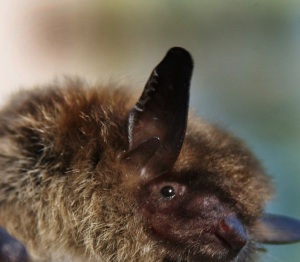What first comes to mind when you think of mammalian breeding pairs? Usually the male is brightly colored and dances in a hypnotic fashion to attract the female of the same species. Little brown bats are unique because they functionally cannot see, and therefore have no effective way of visually attracting a mate. They make breeding look easy…as well as flying in the dark sound easy.
Preparing for torpor- http://youtu.be/AxExwByOb9c <—- Another video!
Myotis lucifugus reproduction is compelling. The mating process happens in an active phase and a passive phase (1). Males and females are both awake during the active phase, but strangely enough the males will mate with torpid bats of both sexes during the passive phase; there is data that shows that about thirty-five percent of mating attempts are homosexual (1). This is possibly because there are no cues from the torpid bat to let the active bat know what sex it is. There are no complicated mating behaviors involved in the process; it is entirely random. Females mate only during the active phase with multiple males, and males will mate with multiple females during both phases. The male will mount the female from behind and vocalize a copulation call so she is aware of his intentions. The females then accumulate sperm from the fall mating season and fertilization occurs during spring ovulation with births happening in June and July following a fifty to sixty day gestation period. Were you ever curious as to how female bats give birth while hanging upside down? I was! The only time you will see a bat in the reversed position with her head up is when she is giving birth. The pup safely lands in her interfemoral membrane, the membrane that is between her hind legs. The pups have fully erupted deciduous teeth, unlike most mammals whose deciduous teeth are not erupted at birth. Deciduous teeth are milk teeth (baby teeth) and then later are replaced with permanent teeth (adult teeth). The pup attaches to a mammary gland and will stay there for about four weeks. Female Myotis lucifugus have one pair of mammary glands because they only have one pup a year.
Within the first couple hours the eyes and ears open up and they can hear by day two. There is a strong bond between mother and offspring. This is the time that the little one will learn behaviors like how to fly and hunt. The pup will stay attached to the mother until it can learn to fly on its own, which is roughly in four weeks (1). The young one will be a part of every activity the mom does on a daily basis; the males have no part in parental care. If a female were to ever lose her young one, she knows her baby by smell and conspecific ( of the same species) calls. The pups can thermo-regulate around ten days after being born by means of torpor (1). Little brown bats, like all bats, are social mammals and strongly communicate behavior and actions through echolocation and non-echolocation calls.
What a great opportunity it would be to see a throng of up to 300,000 bats per roost (1) flying out at dusk or returning at dawn. How are they not colliding? They use echolocation to produce a “3D map” to locate water sources, insects, and irregular surfaces. They recognize other bats by knowing all the different vocal cues that are specific to a certain emotion or action by non-echolocation. Different species of bats do not have the same vocalization cues, like mentioned before, they are conspecific. According to “Social Behavior of Little Brown Bats,” one non-echolocation vocalization is the “agonistic call” in which Myotis lucifugus bare their teeth expressing physical aggression towards another individual (2). They use echolocation pulses in modified forms to prevent collision while in flight(2). Little brown bats are fascinating little mammals that have successfully achieved true flight while being blind. In the next blog the evolution of flight in Myotis lucifugus will be discussed. Along with the anatomy and physiology involved with flight.
Watch this video!
<a href=”http://www.arkive.org/little-brown-myotis/myotis-lucifugus/video-00.html#src=portletV3web” title=”ARKive video – David Attenborough explaining hibernation in little brown myotis” ><img src=”http://cdn2.arkive.org/media/D4/D40705C0-27FE-45B1-BDF9-52E659B82BCB/Presentation.Portlet/David-Attenborough-explaining-hibernation-in-little-brown-myotis.jpg” alt=”ARKive video – David Attenborough explaining hibernation in little brown myotis” title=”ARKive video – David Attenborough explaining hibernation in little brown myotis” border=”0″/></a>
References
- Havens, A. 2006. “Myotis lucifugus” (On-line), Animal Diversity Web. Accessed November 12, 2014 at http://animaldiversity.ummz.umich.edu/accounts/Myotis_lucifugus/
- Social Behavior of the Little Brown Bat, Myotis lucifugus: II. Vocal CommunicationAuthor(s): Robert M. R. Barclay, M. Brock Fenton and Donald W. ThomasSource: Behavioral Ecology and Sociobiology, Vol. 6, No. 2 (1979), pp. 137-146Published by: SpringerStable URL: http://www.jstor.org/stable/4599269 .Accessed: 13/11/2014 02:35

